Nuremberg Trials

There were two sets ofNuremberg Trials.
The first, and most well known, were the trials of the leaders ofNazi Germany.This was organized by theInternational Military Tribunal(IMT). The judges and prosecutors were from the four wartime Allies,France,theUSSR,theUnited Kingdomand theUnited States.
The second set of trials were the 12follow up trials(German:nachfolgende Prozesse). These trials were of groups of lower-ranking Nazis, like doctors, and officials of the German Foreign Office. Although the follow up trials were held in the same courtroom as the IMT trials, they were run by the Americans alone.
The main trial[change|change source]

The International Military Tribunal was opened on October 18, 1945, in the Supreme Court Building inBerlin.The first session was presided over by the Soviet judge, Nikitchenko. The prosecution brought charges against 24 major war criminals and sixcriminal organizations– the leadership of theNazi Party,theSchutzstaffel(SS) andSicherheitsdienst(SD), theGestapo,theSturmabteilung(SA) and the High Command of the German armed forces (OKW).
The indictments were for:
- Working with other people (legally called "Taking part in aconspiracy") to commit acrime against peace
- War crimes
- Crimes against humanity
- Planning, initiating and wagingwars of aggressionand other crimes against peace
The 24 accused were:
"I"indicted"G"indicted and found guilty"O"Not Charged
| Name | Count | Sentence | Notes | |||
|---|---|---|---|---|---|---|
| 1 | 2 | 3 | 4 | |||
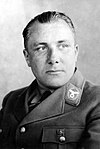 |
I | O | G | G | Death | Successor to Hess as Nazi Party Secretary. Sentenced to death while not being at the courtroom. His body was found in 1972.[1] |
 |
I | G | G | O | 10 years | Leader of theKriegsmarine,the Navy, from 1943. Started theU-boatcampaign. BecamePresident of Germanyafter Hitler's death.[2]In evidence presented at the trial ofKarl Dönitzon his orders to theU-boatfleet to breach theLondon Rules,AdmiralChester Nimitzstated thatunrestricted submarine warfarewas carried on in thePacific Oceanby theUnited Statesfrom the first day that nation entered the war. Dönitz was found guilty of breaching the 1936Second London Naval Treaty,but his sentence was not assessed on the ground of his breaches of the international law of submarine warfare.[3] |
 |
I | O | G | G | Death | Reich Law Leader 1933–1945 and Governor-General of theGeneral Governmentin occupiedPoland1939–1945. Expressed sorrow.[4] |
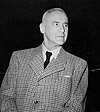 |
I | G | G | G | Death | Hitler's Minister of the Interior 1933–1943 and Reich Protector of Bohemia-Moravia 1943–1945. One of the writers of theNuremberg Race Laws.[5] |
 |
I | I | I | O | Acquitted | Popular radio commentator, and head of the news division of the NaziPropaganda Ministry.Tried in place ofJoseph Goebbels.[6] |
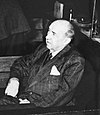 |
I | G | G | G | Life Imprisonment | Hitler's Minister of Economics. Succeeded Schacht as head of theReichsbank.Released due to ill health on May 16, 1957.[7] |
 |
G | G | G | G | Death | Commander of theLuftwaffe1935–1945, Chief of the 4-Year Plan 1936–1945, and several departments of theSS,Prime Minister ofPrussia.Committedsuicidethe night before his execution.[8] |
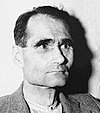 |
G | G | I | I | Life Imprisonment | Hitler's deputy, flew to Scotland in 1941 to try to make peace with Great Britain. After trial he was sent to Spandau Prison; died there in 1987.[9] |
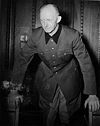 |
G | G | G | G | Death | Wehrmacht.Keitel's deputy and Chief of theOKW's Operations Division 1938–1945. Later exonerated by German court in 1953.[10] |
 |
I | O | G | G | Death | Highest survivingSS-leader. Chief ofRSHA1943–45, the central Nazi intelligence office. Also, commanded many of theEinsatzgruppenand severalconcentration camps.[11] |
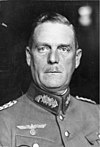 |
G | G | G | G | Death | Head ofOberkommando der Wehrmacht(OKW) 1938–1945.[12] |
 |
I | I | I | ---- | Major Nazi industrialist. CEO of Krupp AG 1912–45. Medically unfit for trial. The prosecutors attempted to substitute his son Alfried (who ran Krupp for his father during most of the war) in the indictment, but the judges rejected this as being too close to trial. Alfried was tried in a separate Nuremberg trial for his use of slave labor, thus escaping the worst notoriety and possibly death. | |
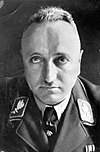 |
I | I | I | I | ---- | Head ofDAF,The German Labour Front. Suicide on October 25, 1945, before the trial began. |
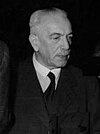 |
G | G | G | G | 15 years | Minister of Foreign Affairs 1932–1938, succeeded byvon Ribbentrop.Protector ofBohemiaandMoravia1939–43. Resigned in 1943 after a dispute with Hitler. Released because of ill health on November 6, 1954.[13] |
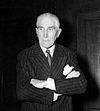 |
I | I | O | O | Acquitted | Chancellor of Germanyin 1932 and Vice-Chancellor under Hitler in 1933–1934. Ambassador toAustria1934–38 and ambassador toTurkey1939–1944. Although acquitted at Nuremberg, von Papen was classed as a war criminal in 1947 by a Germande-Nazificationcourt, and sentenced to eight years' hard labour. He was acquitted following appeal after serving two years.[14] |
 |
G | G | G | O | Life Imprisonment | Commander-in-Chief of theKriegsmarinefrom 1928 until his retirement in 1943, succeeded by Dönitz. Released because of ill health on September 26, 1955.[15] |
 |
G | G | G | G | Death | Ambassador-Plenipotentiary 1935–1936. Ambassador to the United Kingdom 1936–1938. Minister of Foreign Affairs 1938–1945.[16] |
 |
G | G | G | G | Death | Racial theoryideologist. Later, Minister of the Eastern Occupied Territories 1941–1945.[17] |
 |
I | I | G | G | Death | Gauleiterof Thuringia 1927–1945. Plenipotentiary of the Nazi slave labor program 1942–1945.[18] |
 |
I | I | O | O | Acquitted | Prominent banker and economist. President of theReichsbank1923–1930 and 1933–1938 and Economics Minister 1934–1937. Admitted breaking theTreaty of Versailles.[19] |
 Baldur von Schirach(standing) |
I | O | O | G | 20 years | Head of theHitlerjugendfrom 1933 to 1940,GauleiterofVienna1940–1943. Expressed sorrow.[20] |
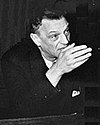 |
I | G | G | G | Death | Helped theAnschluß(joining Germany and Austria). Was briefly Austrian Chancellor 1938. Deputy to Frank in Poland 1939–1940. Later, Reich Commissioner of the occupied Netherlands 1940–1945. Expressed sorrow.[21] |
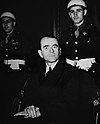 |
I | I | G | G | 20 Years | Hitler's favourite architect and personal friend, and Minister of Armaments from 1942. As Minister of Armaments, he used slave labour from the occupied territories in armaments production. Expressed sorrow.[22] |
 |
I | O | O | G | Death | Gauleiterof Franconia 1922–1945. Incited hatred and murder against the Jews through his weekly newspaper,Der Stürmer.[23] |
"I"indicted"G"indicted and found guilty"O"Not Charged
The death sentences were carried out on 16 October 1946 byhangingusing the inefficient American "standard" drop method instead of the long drop.[24][25]The executioner wasJohn C. Woods.The French judges suggested the use of a firing squad for the military condemned, as is standard for military courts-martial, but this was opposed by Biddle and the Soviet judges. They said that the military officers acted so badly they did not deserve to be treated as soldiers. The prisoners sentenced to jail were transferred toSpandau Prisonin 1947.
The definition of what constitutes a war crime is described by theNuremberg Principles,a document which was created as a result of the trial. The medical experiments conducted by German doctors and prosecuted in the so-calledDoctors' Trialled to the creation of theNuremberg Codeto control future trials involving human subjects.
Four organisations were charged as being criminal. Only the SS was found guilty. These organisations were found not to be criminal:
- Reichsregierung, (the Reich government orCabinet)
- Oberkommando and Generalstab der Wehrmacht, (the High Command and General Staff of the Armed Forces)
- Sturmabteilung (the Stormtroopers or "Brownshirts" )
Related pages[change|change source]
References[change|change source]
- ↑"Bormann judgement".Archived fromthe originalon 2006-12-31.Retrieved2007-12-24.
- ↑"Dönitz judgement".Archived fromthe originalon 2012-08-19.Retrieved2007-12-24.
- ↑President of the Reich for 23 days afterAdolf Hitler's suicide.Judgement: DoenitzArchived2012-08-19 at theWayback MachinetheAvalon Projectat theYale Law School
- ↑"Frank judgement".Archived fromthe originalon 2006-11-17.Retrieved2007-12-24.
- ↑"Frink judgement".Archived fromthe originalon 2006-12-31.Retrieved2007-12-24.
- ↑"Fritzsche judgement".Archived fromthe originalon 2006-12-31.Retrieved2007-12-24.
- ↑"Funk judgement".Archived fromthe originalon 2007-01-04.Retrieved2007-12-24.
- ↑"Goering judgement".Archived fromthe originalon 2007-01-04.Retrieved2007-12-24.
- ↑"Hess judgement".Archived fromthe originalon 2006-12-21.Retrieved2007-12-24.
- ↑"Jodl judgement".Archived fromthe originalon 2006-12-01.Retrieved2007-12-24.
- ↑"Kaltenbrunner judgement".Archived fromthe originalon 2007-01-03.Retrieved2007-12-24.
- ↑"Keitel judgement".Archived fromthe originalon 2006-12-20.Retrieved2007-12-24.
- ↑"Von Neurath judgement".Archived fromthe originalon 2007-01-03.Retrieved2007-12-24.
- ↑"Von Papen judgement".Archived fromthe originalon 2007-01-03.Retrieved2007-12-24.
- ↑"Raeder judgement".Archived fromthe originalon 2007-01-03.Retrieved2007-12-24.
- ↑"Von Ribbentrop judgement".Archived fromthe originalon 2006-12-11.Retrieved2007-12-24.
- ↑"Rosenberg judgement".Archived fromthe originalon 2007-01-01.Retrieved2007-12-24.
- ↑"Sauckel judgement".Archived fromthe originalon 2007-01-03.Retrieved2007-12-24.
- ↑"Schacht judgement".Archived fromthe originalon 2007-01-03.Retrieved2007-12-24.
- ↑"Von Schirach judgement".Archived fromthe originalon 2006-12-31.Retrieved2007-12-24.
- ↑"Seyß-Inquart judgement".Archived fromthe originalon 2011-11-04.Retrieved2007-12-24.
- ↑"Speer judgement".Archived fromthe originalon 2007-01-02.Retrieved2007-12-24.
- ↑"Streicher judgement".Archived fromthe originalon 2007-01-01.Retrieved2007-12-24.
- ↑"Judgment at Nuremberg"(PDF).Archived fromthe original(PDF)on 2016-06-25.Retrieved2007-12-24.
- ↑"The trial of the century".Archived fromthe originalon 2010-06-10.Retrieved2007-12-24.
| TheNuremberg Trials | ||||||||||||||||||||||||
| Trial of the Major War Criminals before the International Military Tribunal | ||||||||||||||||||||||||
| Trials before the U.S.Nuremberg Military Tribunals | ||||||||||||||||||||||||
|
